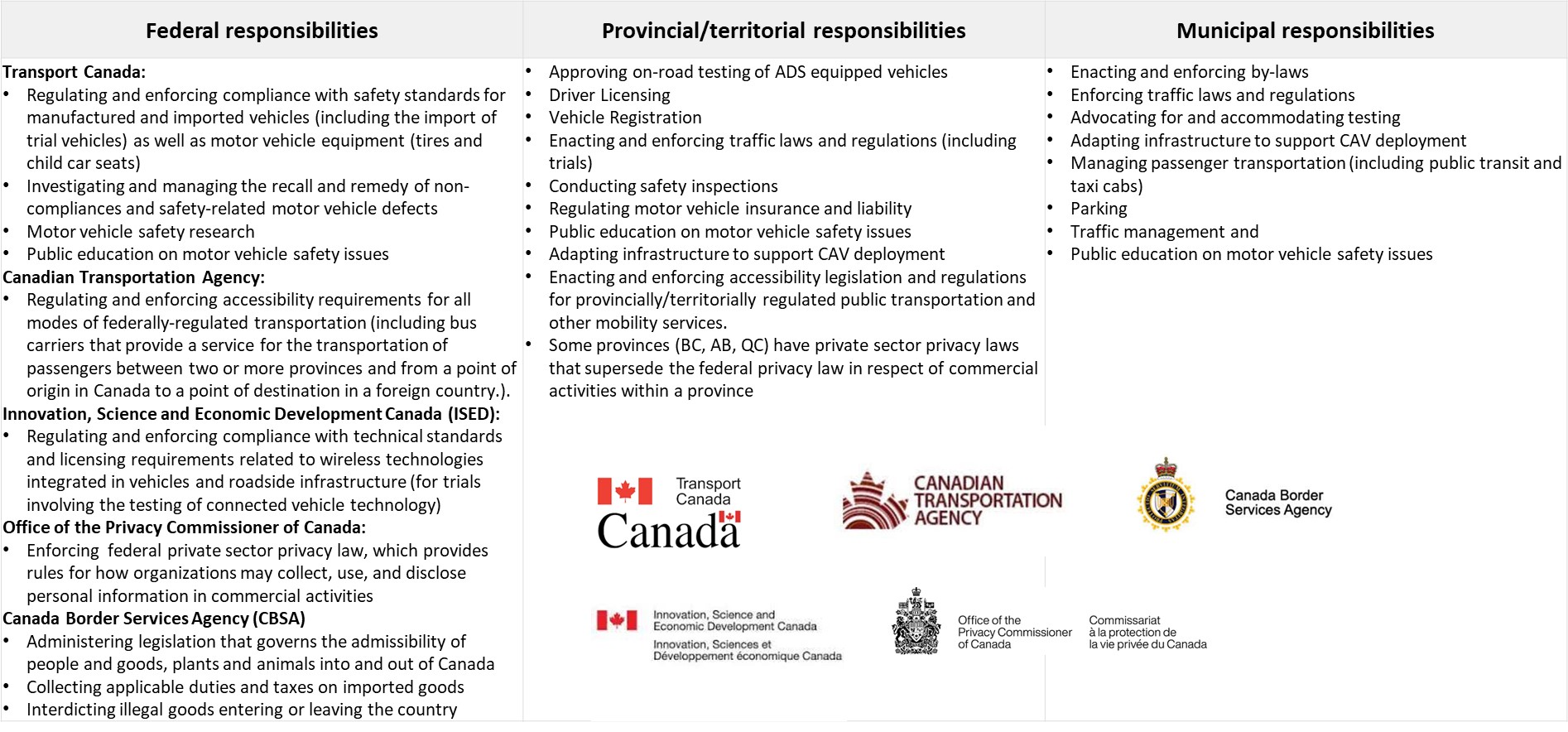
Transport Canada Releases Updated Guidelines for Testing Automated Driving Systems
Autonomous vehicles will play a key role in the future of mobility. Ministry of Transport (MoT), Government of Canada released the Guidelines for Testing Automated Driving Systems in Canada Version 2.0. The government released the original guidelines in 2018 – Testing Highly Automated Vehicles in Canada: Guidelines for Trial Organizations. The new guidelines incorporate new best practices and technical standards for automated driving systems developed by the international community around the world and within Canada.
The key objective of the new guidelines is to:
- establish a baseline of best practices to ensure that on-road testing and trials involving ADS vehicles are done safely
- clarify the roles and responsibilities of federal, provincial or territorial, and municipal governments as it relates to trial organizations
- emphasize safety, accessibility, efficiency, and collaboration with government, stakeholders, and international partners

These guidelines will provide clarity on various roles and responsibilities of federal, provincial, and territorial, as well as municipal governments in approving and facilitating trials of ADS-equipped vehicles. Further, it will highlight the safety requirements for trial organizations, conducting research and development testing of automated driving system (ADS) vehicles in Canada.
Autonomous mobility is evolving around the world and it is important to lessons learned from domestic and international testing activities. Further, the guidelines shared some best practices on assessing the safety of test vehicles, route selection, safety drivers and remote operations, and passenger safety.
Chapter 1: Engagement with Government Agencies
In Canada, road safety is a shared responsibility between federal, provincial, and territorial governments. The guidelines highlighted the responsibilities of each level of government in Canada and the approvals trial organizations must seek prior to conducting testing. Key responsibilities of each stakeholder include:
- Transport Canada – responsible for publishing the Motor Vehicle Safety Act (MVSA), which covers safety regulations for the manufacture and importation of motor vehicles, as well as designated motor vehicle equipment, and the shipment of newly manufactured vehicles and equipment across provincial and territorial boundaries
- Provinces and territories – responsible for the licensing of drivers, vehicle registration, and insurance, as well as laws and regulations regarding vehicle maintenance and the safe operation of vehicles on public roads
- Municipal governments – generally responsible for: the enactment and enforcement of by-laws concerning vehicle movement; the use of local infrastructure; and, the provision of public transportation in their respective jurisdictions
Generally, municipal authorities, along with provincial and territorial road transportation agency are responsible for local traffic and infrastructure for autonomous vehicle driving.

Chapter 2: Pre-Trial Considerations
The guidelines clearly outlined the safety considerations for commencing testing, covering key areas:
- Safety of the test vehicles – vehicles equipped with SAE level 3 to 5 ADS should review the safety of their test vehicles and develop safety assessment reports using the Safety Assessment for Automated Driving Systems in Canada
- Selection of test routes – consider the ADS’s operational design domain (ODD) and object and event detection and response (OEDR) capacities when selecting a route or operating environment
- Safety management plans – outline all necessary safety procedures including at the start of a test, during vehicle operations, and at the end of the test
- Safety drivers – provide proper training and safety licenses to drivers to operate test vehicles
- Public communication plans – to inform the public and other road users of trials on public roads, including testing site, the vehicle’s capabilities, and limitations, as well as instructions on how other road users can expect to interact with the test vehicle throughout the trial
- Engagement with local law enforcement and emergency response personnel – should be briefed on local trials to ensure that they are aware and prepared to respond to collisions or other incidences that may occur
Chapter 3: Test Considerations
The guidelines highlight the safety issues that should be considered and revisited throughout the trial process, covering key areas:
- Graduated approach to testing – the gradual introduction of complexity and risk when testing an ADS, e.g. start testing in a restricted operating environment such as a closed track before moving to more complex environments and/or operations
- Adapting safety management strategies during trial operations – discover unforeseen hazards, system performance challenges or note other important safety observations that were not considered during the initial development of the safety management plan
- Incident response plans & emergencies – should develop and maintain incident and emergency response plans in consultation with local first responders based on a risk assessment of their trial activities
- Safety driver responsibilities – intervene and assume manual control of the test vehicle in the event that the ADS does not function or exceeds its ODD requiring assistance to achieve a minimal risk condition
- Remote driving – provide varying degrees of remote support to test vehicles, and in some cases, allow a remote driver to take over the dynamic driving task from an ADS-equipped vehicle
- Trial with passengers – introduce additional complexity and safety and security risks that need to be appropriately managed
- Regular reporting and information sharing – periodically engage with provincial or territorial road transportation agencies to provide updates on testing activities
Chapter 4: Post-test Considerations
Post-trial is important for all stakeholders. The chapters require trial organizations will have to consider after concluding their testing activities, including:
- Reporting on trial outcomes – share best practices and lessons learned with respect to the conduct of trials and to provide feedback to relevant federal, provincial and territorial authorities regarding the regulatory requirements and permit procedures
- Export, disposal or donation of testing vehicles – imported testing vehicle must either be exported from the country or destroyed under the supervision of a CBSA agent upon the expiration of the Declaration and evidence of such provided to Transport Canada
The guidelines cover many important points and provide good guidance for the organizations which are looking to test autonomous vehicles in Canada.

Sorry, the comment form is closed at this time.



Pingback: Industry Alliance released the first Association Standards on Autonomous Buses in China - Mobility Innovators
Pingback: User acceptance and perception of autonomous vehicles | Guido di Pasquale - Mobility Innovators